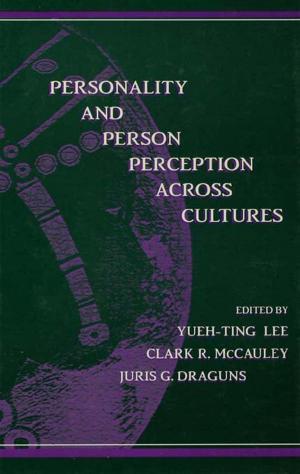Recognizing The Latino Resurgence In U.s. Religion
The Emmaus Paradigm
Nonfiction, Social & Cultural Studies, Social Science, Sociology| Author: | Ana Maria Diaz-stevens | ISBN: | 9780429977435 |
| Publisher: | Taylor and Francis | Publication: | February 12, 2018 |
| Imprint: | Routledge | Language: | English |
| Author: | Ana Maria Diaz-stevens |
| ISBN: | 9780429977435 |
| Publisher: | Taylor and Francis |
| Publication: | February 12, 2018 |
| Imprint: | Routledge |
| Language: | English |
This book delivers a knockout blow to the old notion that Latinos and Latinas are just another immigrant group waiting to be assimilated. Taking as analogy the scriptural episode of Emmaus in which Jesus walked unrecognized alongside his disciples, the authors detail how after nearly a century of unrecognized presence, the nations more than 25 million Latinos and Latinas began, in 1967, to use religion as a major source of the social and symbolic capital to fortify their identity in American society. Ana Mara Daz-Stevens and Anthony M. Stevens-Arroyo describe how this Latino Religious Resurgence has created a church-based model of multicultural pluralism that challenges the current trend of U.S. politics. }Emmaus is the biblical episode that recounts how the disciples, who had been unable to recognize the resurrected Jesus even as he traveled with them, finally come to know him as their Lord through his inspirational conversation. In this major new work exploring Latino religion, Ana Mara Daz-Stevens and Anthony M. Stevens-Arroyo compare a century-old presence of Latinos and Latinas under the U.S. flag to the Emmaus account. They convincingly argue for a new paradigm that breaks with the conventional view of Latinos and Latinas as just another immigrant group waiting to be assimilated into the U.S. The authors suggest instead the concept of a colonized people who now are prepared to contribute their cultural and linguistic heritage to a multicultural and multilingual America.The first chapter provides an overview of the religious and demographic dynamics that have contributed a specifically Latino character to the practice of religion among the 25 million plus members of what will become the largest minority group in the U.S. in the twenty-first century. The next two chapters offer challenging new interpretations of tradition and colonialism, blending theory with multiple examples from historical and anthropological studies on Latinos and Latinas. The heart of the book is dedicated to exploring what the authors call the Latino Religious Resurgence, which took place between 1967 and 1982. Comparing this period to the Great Awakenings of Colonial America and the Risorgimento of nineteenth-century Italy, the authors describe a unique combination of social and political forces that stirred Latinos and Latinas nationally. Utilizing social science theories of social movement, symbolic capital, generational change, a new mentalit, and structuration, the authors explain why Latinos and Latinas, who had been in the U.S. all along, have only recently come to be recognized as major contributors to American religion. The final chapter paints an optimistic role for religion, casting it as a binding force in urban life and an important conduit for injecting moral values into the public realm.Offering an extensive bibliography of major works on Latino religion and contemporary social science theory, Recognizing the Latino Resurgence in U. S. Religion makes an important new contribution to the fields of sociology, religious studies, American history, and ethnic and Latino studies.
This book delivers a knockout blow to the old notion that Latinos and Latinas are just another immigrant group waiting to be assimilated. Taking as analogy the scriptural episode of Emmaus in which Jesus walked unrecognized alongside his disciples, the authors detail how after nearly a century of unrecognized presence, the nations more than 25 million Latinos and Latinas began, in 1967, to use religion as a major source of the social and symbolic capital to fortify their identity in American society. Ana Mara Daz-Stevens and Anthony M. Stevens-Arroyo describe how this Latino Religious Resurgence has created a church-based model of multicultural pluralism that challenges the current trend of U.S. politics. }Emmaus is the biblical episode that recounts how the disciples, who had been unable to recognize the resurrected Jesus even as he traveled with them, finally come to know him as their Lord through his inspirational conversation. In this major new work exploring Latino religion, Ana Mara Daz-Stevens and Anthony M. Stevens-Arroyo compare a century-old presence of Latinos and Latinas under the U.S. flag to the Emmaus account. They convincingly argue for a new paradigm that breaks with the conventional view of Latinos and Latinas as just another immigrant group waiting to be assimilated into the U.S. The authors suggest instead the concept of a colonized people who now are prepared to contribute their cultural and linguistic heritage to a multicultural and multilingual America.The first chapter provides an overview of the religious and demographic dynamics that have contributed a specifically Latino character to the practice of religion among the 25 million plus members of what will become the largest minority group in the U.S. in the twenty-first century. The next two chapters offer challenging new interpretations of tradition and colonialism, blending theory with multiple examples from historical and anthropological studies on Latinos and Latinas. The heart of the book is dedicated to exploring what the authors call the Latino Religious Resurgence, which took place between 1967 and 1982. Comparing this period to the Great Awakenings of Colonial America and the Risorgimento of nineteenth-century Italy, the authors describe a unique combination of social and political forces that stirred Latinos and Latinas nationally. Utilizing social science theories of social movement, symbolic capital, generational change, a new mentalit, and structuration, the authors explain why Latinos and Latinas, who had been in the U.S. all along, have only recently come to be recognized as major contributors to American religion. The final chapter paints an optimistic role for religion, casting it as a binding force in urban life and an important conduit for injecting moral values into the public realm.Offering an extensive bibliography of major works on Latino religion and contemporary social science theory, Recognizing the Latino Resurgence in U. S. Religion makes an important new contribution to the fields of sociology, religious studies, American history, and ethnic and Latino studies.















